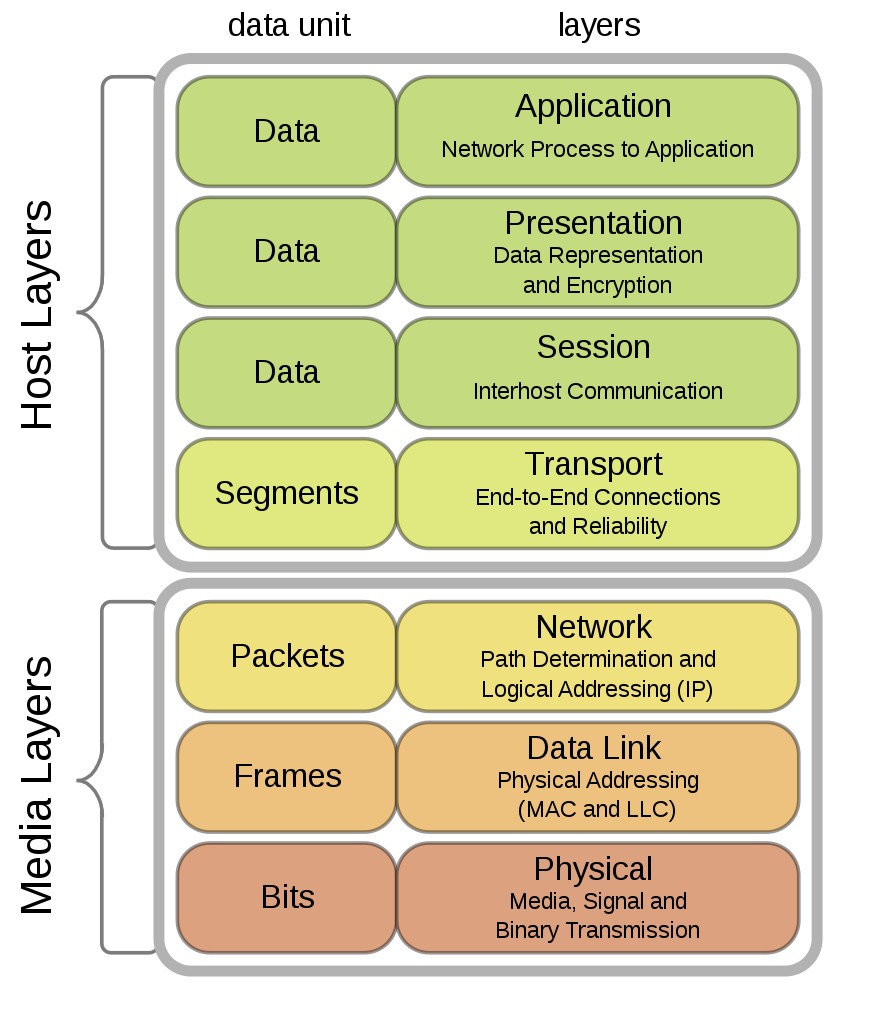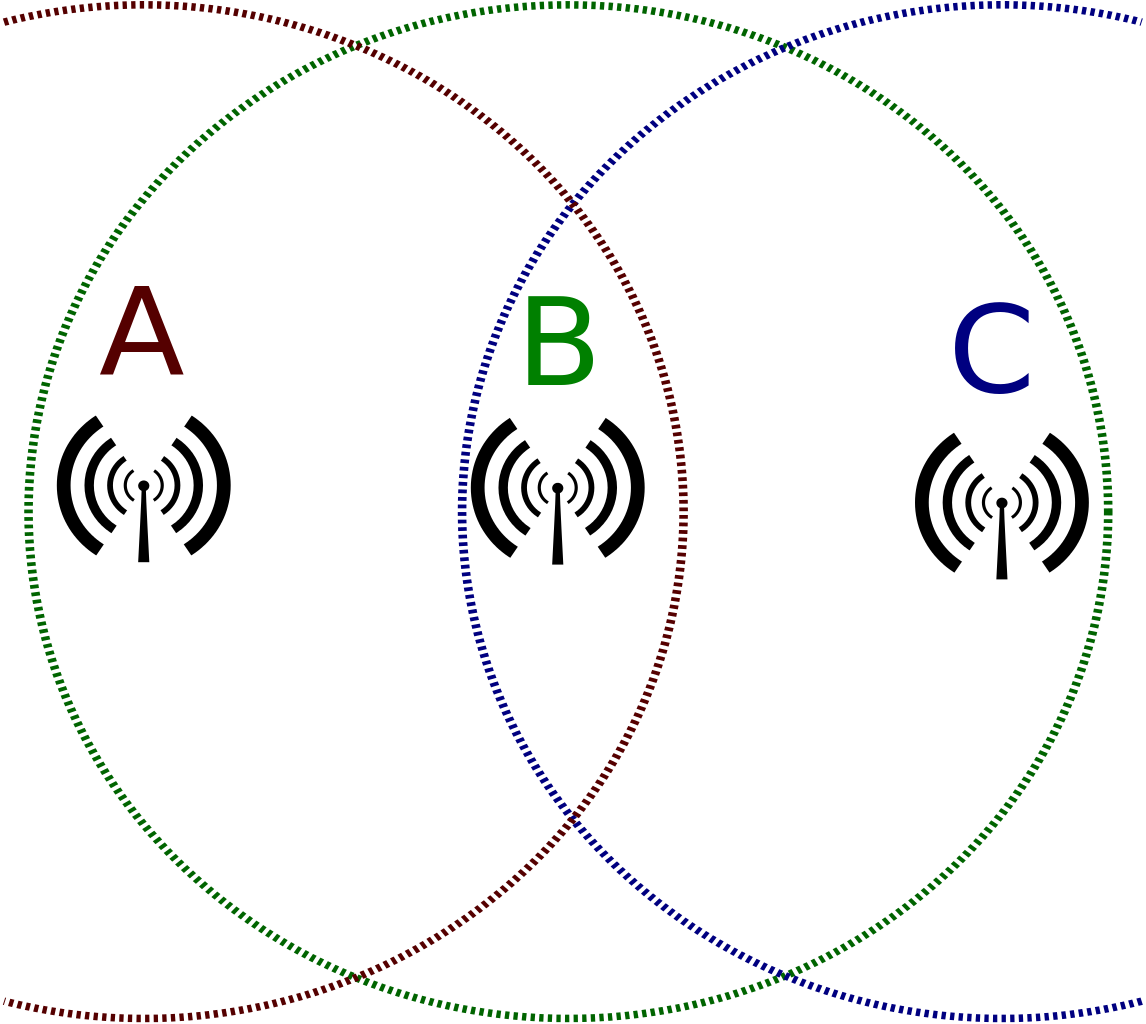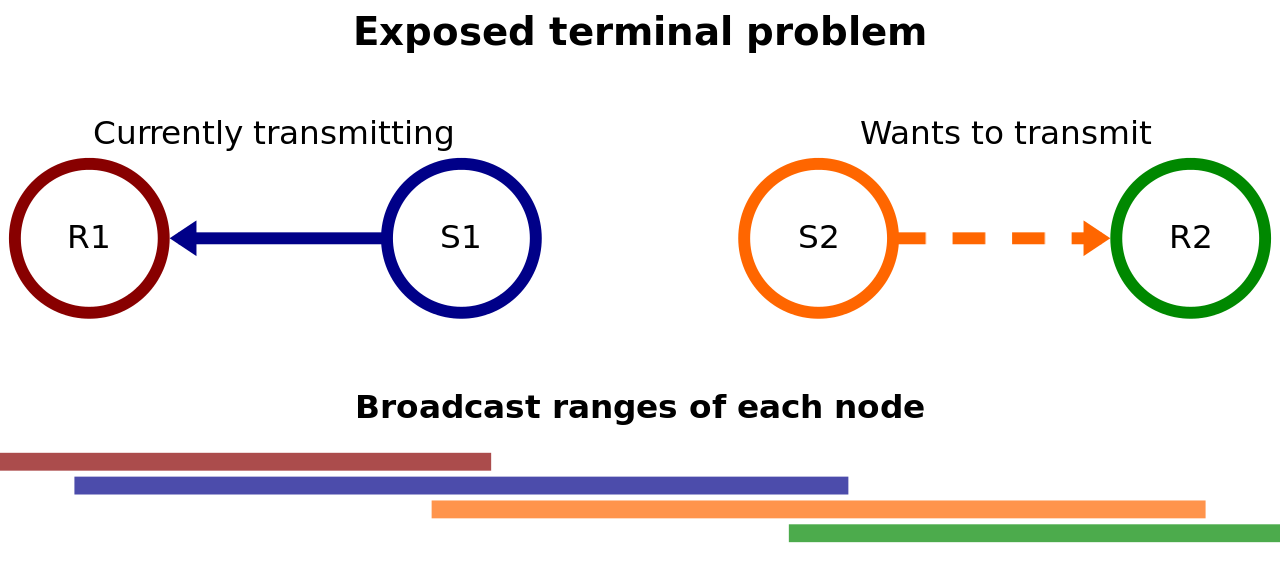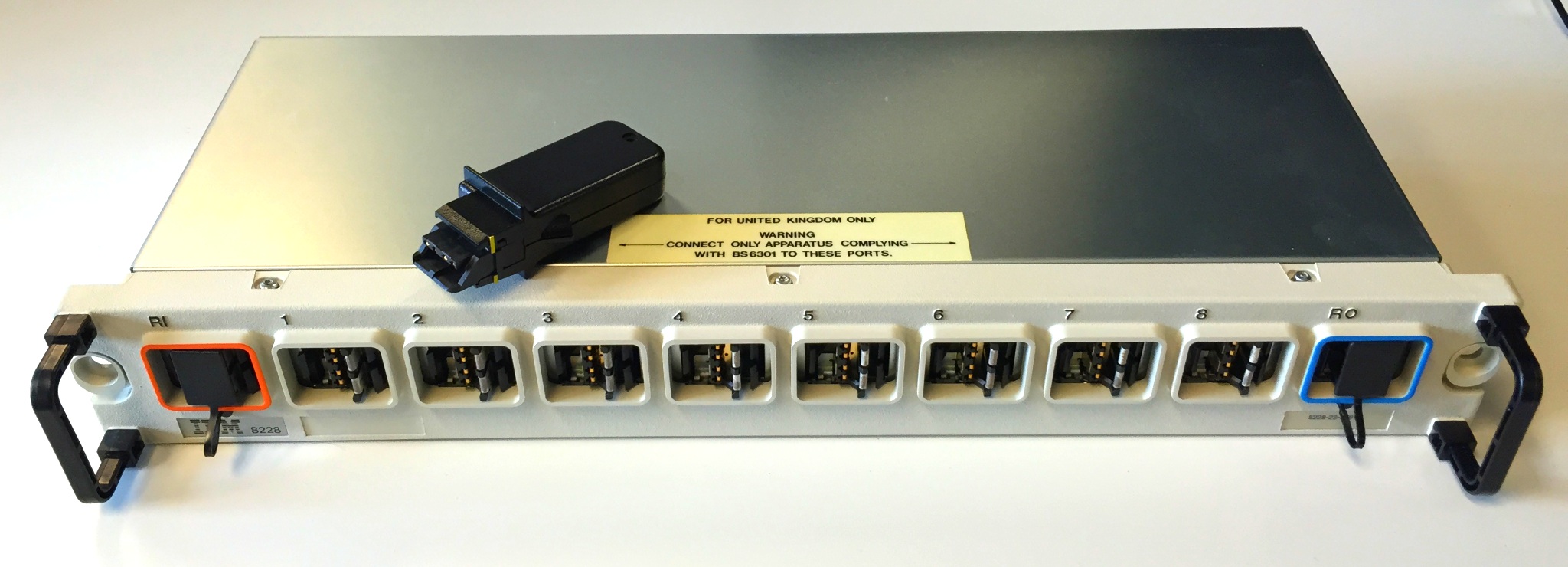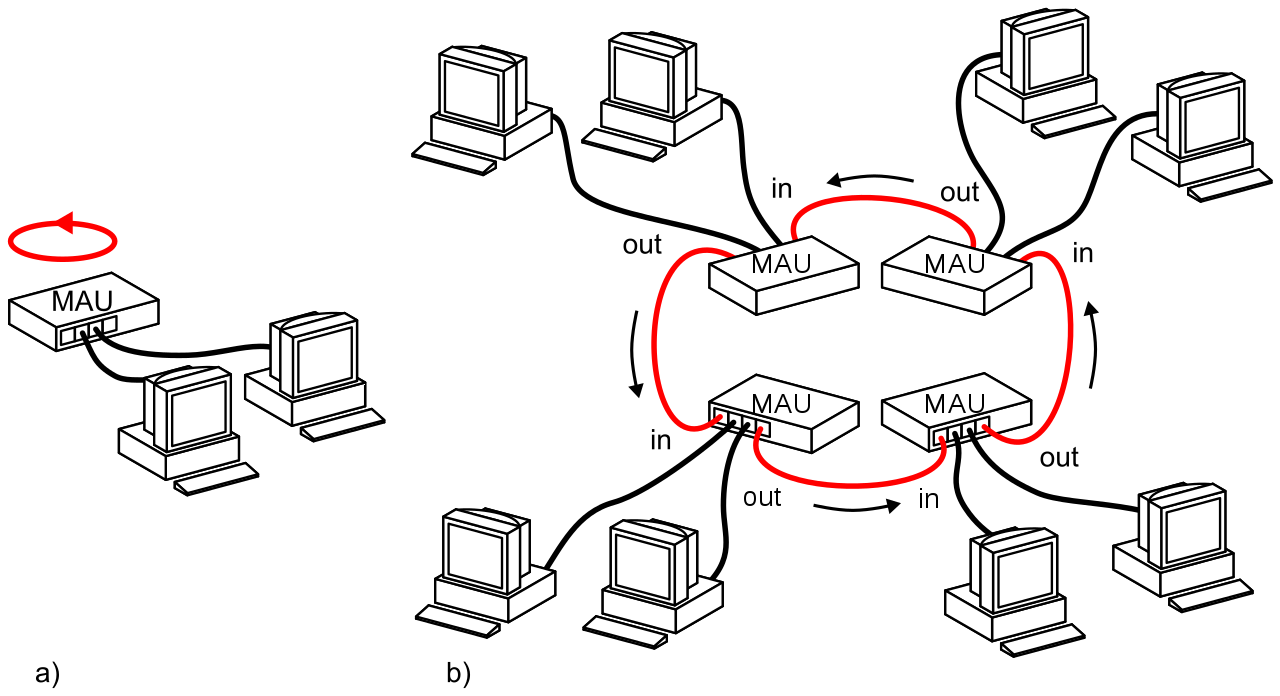Medium Access Control
(Press ? for help, n and p for next and previous slide; usage hints)
Mo, Yilin
Oct 2020

Introduction
Core Questions
- What purpose does the data link layer serve in OSI network model?
- How does collision occur in wireless communication?
- What are hidden and exposed terminal problem?
- What are the major categories for medium access control protocols?
- How to save energy in the MAC protocol?
Learning Objectives
- Definition of the data link layer in the OSI network model
- Medium Access Control
- Logical Link Control
- Characteristics of collision problem in wireless communication
- Hidden terminal problem
- Exposed terminal problem
- MAC layer protocols
- Deterministic access
- Ordered access
- Random access
Table of Contents
Overview
OSI 7-Layer Network Model
Data-Link Layer
- Physical Layer: handles transmission of raw bits
- What is not taken care of…
- Handling collision
- Multiplexing
- Error checking
- Framing
Data-Link Layer
- Logical Link Control (LLC)
- IEEE 802.2 standard
- recognizing where frames begin and end in the bit-stream
- (de)multiplexing different protocols to be transmitted over the MAC layer
- optionally providing flow control, and detection and retransmission of dropped frames
- Usually provided by transport layer protocols (TCP) in an end-to-end fashion
- Medium/Media Access Control (MAC)
What is MAC?
- Defines how a node obtains a channel when it needs to
- Determines who gets to send data at any given time
- Avoid Collision
Design Considerations
- What kind of a resource do we have?
- Frequency: bandwidth
- Time: Latency
- Energy
- How much does a node need?
- How often?
- How regular? Is the communication bursty or not?
- What kind of a “guarantee” should be provided?
- Do we need central control or “let things happen as they may”?
- Complexity/Fairness/…
The Collision Problem in Wireless Communications
- Two nodes send to the same node at the same time
- Interference of data: data loss
Ethernet vs. Wireless
- Ethernet
- Medium is clear
- if you sense no carrier, there is no one sending data on the wire
- Node can send and receive at the same time
- Medium is clear
- Wireless LAN
- Medium is not clear
- possible that some node is sending data but is out of your range
- Cannot send and receive at the same time
- (assuming a single frequency)
- Medium is not clear
The “Hidden Terminal” Problem
- Station C is sending data to station B.
- Station A wants to do the same and listens for other frames being sent.
- Since A is out of the range of station C, it does NOT notice its frames and thinks the media is free.
A and C transmit simultaneously to B, and B loses both frames.
The “Exposed Terminal” Problem
- The two transmitters (S1, S2) in the middle are in range of each other.
- The two receivers (R1, R2) are out of range of each other
- If a transmission between S1 and R1 is taking place:
- However, S2 can “hear” S1’s transmission
- S2 concludes that it will interfere with S1
- So S2 chooses NOT to transmit
However R1 cannot hear S2 and R2 cannot hear S1.
Wasted Energy in Communication
- Collisions
- Data become corrupted
- Expend more energy for re-transmission
- Overhearing
- Receiving a frame intended for another node
- Expend energy receiving a frame that is useless
- Control Packet Overhead
- Large overhead translates into sending larger packets or more packets, and therefore more energy expended
- Idle Listening
- Waiting to receive a frame
- Receiver expends energy and receives no data
- #1 source of wasted energy
Collision Problem (Wireless Version)
- Collision cannot be sensed when transmitting
- Hidden Terminal problem
- Exposed Terminal problem
- Energy concern
Types of MAC
- Ordered Access
- Deterministic Access
- Some of the protocols are in the physical layer
- Random Access/Contention-Based Access
- Hybrid
Ordered Access
Ordered Access
- Not random
- Not controlled by a central control point that allocates channels
- Token Ring
- Introduced by IBM in 1984
- Standardized in 1989 as IEEE 802.5
- Was successful in corporate environments
- Taken over by Ethernet (Random Access)
Token Passing
Only the system which has some “token” can communicate
Token is passed to the next candidate in a sequential manner
Problems with Ordered Access
- How about in a wireless network?
- Nodes might leave?
- Break the Order
- Take away the token
Deterministic Access
Deterministic Access
- Controlled by a central control point that allocates channels
- Time Division Multiple Access (TDMA)
- Frequency Division Multiple Access (FDMA)
- Space Division Multiple Access (SDMA)
- Code Division Multiple Access (CDMA)
- Requires access points for coordination
Frequency Division & Time Division
- Frequency Division Duplexing (FDD)
- Two distinct frequencies at the same time for the two directions
- Capacity is determined by frequency band allocation, making it difficult to make a dynamic change.
- Time Division Duplexing (TDD)
- Two distinct sets of time slots on the same frequency for the two directions
- Cheaper since without the need of a diplexer to isolate transmission and receptions.
- Possible to change the uplink and downlink capacity ratio dynamically according to the needs.
- Time latency because only half-duplex
- Guard period is necessary
- Both are used in 4G (not compatible)
- China Unicom, Telecom: FDD
- China Mobile: TDD -> FDD
Time & Frequency Division Multiple Access (TDMA & FDMA)
- TDMA: Multiple users share the same frequency band via repeating “time slots”
- Transmission for any user is non-continuous: buffer-and-burst digital data & modulation needed, lower battery consumption
- Larger overhead: synchronization bits for each data burst, guard bits for variations in propagation delay and delay spread
- FDMA: Assign different frequency bands to individual users
- Available spectrum is divided into a number of “narrowband” channels
LTE Resource Block [Lea2018]
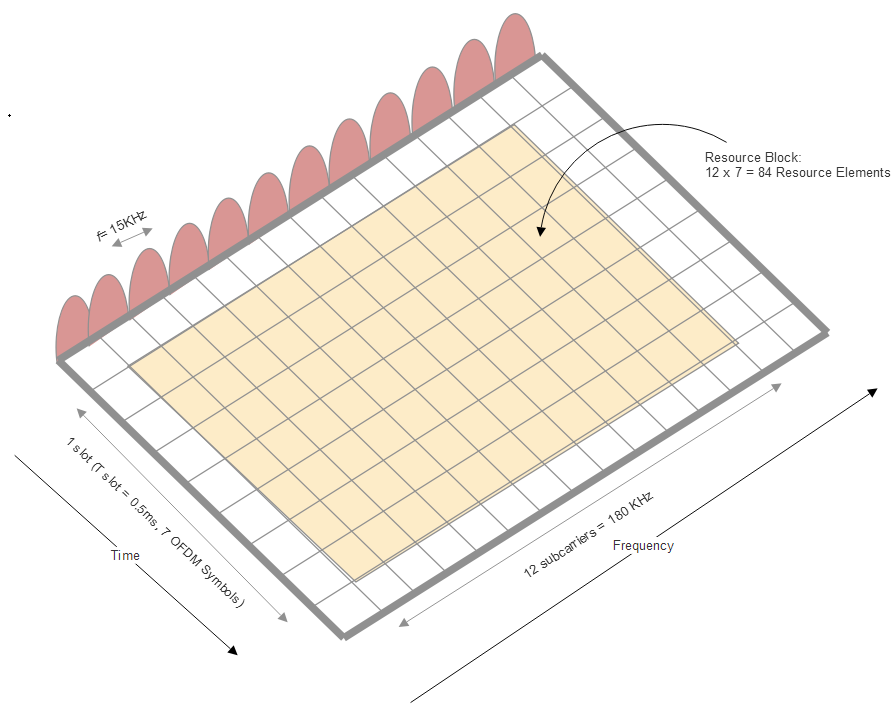
LTE Resource Block
LTE Resource Block
- Each LTE frame is 10ms and 20MHz, 2MHz of which are used as guard band.
- A resource block of 180kHz and 0.5ms can be allocated to each user.
- \( (20-2)/0.18 \times 10/0.5 = 2000 \) resource blocks in 1 frame.
- Each resource block is further divided into \(12\times 15Khz \) subcarriers.
- 7 symbols can be transmitted by 1 subcarrier (\(0.5 ms \times 15kHz\))
- 1 resource block can transmit 84 OFDM symbols
- \(84\times 2000 = 168k\) OFDM symbols can be transmitted in 1 frame
- The symbol rate is 16.8M/s
- Assuming 64-QAM, the raw bit rate is \(16.8\times \log_264 = 100.8Mbps\).
- With \(2\times 2\) MIMO, the throughput can be further increased to 201.6Mbps.
Code Division Multiple Access (CDMA)
- Exploits mathematical properties of orthogonality
- The code from different users are orthogonal to each other
- or “statistically” orthogonal if PN sequence is used
- To decode the signal, one need to compute the inner product of the received signal with the corresponding PN sequence.
Space Division Multiple Access (SDMA)
- Traditional mobile network has no information on the position of the mobile units
- Hence, the signal is transmitted in all directions
- Likewise, in reception, the antenna receives signals coming from all directions
- including interference signals.
- For SDMA, the antenna, both in transmission and reception, is adapted to each user to obtain highest gain in the direction of that user.
- This is often done using phased array techniques.
Random Access
Random Access
- Randomly access media, usually detect collision after it happens
- ALOHA
- Carrier Sense Multiple Access (CSMA)
- Carrier Sense Multiple Access w/ Collision Detection (CSMA/CD)
- Carrier Sense Multiple Access w/ Collision Avoidance (CSMA/CA)
ALOHA
- ALOHAnet was a pioneering computer networking system developed at the University of Hawaii.
- Became operational in June, 1971,
- the first public demonstration of a wireless packet data network.
- ALOHA originally stood for Additive Links On-line Hawaii Area.
- The ALOHAnet employed
- a new medium access control: ALOHA protocol
- and UHF: 300Mhz - 3GHz
- ARPANET: each node could only talk directly to a node at the other end of a wire or satellite circuit
Slotted ALOHA
- Time is divided into “slots” of one frame duration
- E.g., fixed size frames
- When a node has a frame to send, it waits until the start of the next slot to send it
- Requires synchronization
- If no other nodes attempt transmission during that slot, the transmission is successful
- Otherwise “collision”
- Collided frames are re-transmitted after a random delay
- Simple and has low latency under low traffic
- But not efficient under high traffic
Slotted ALOHA
Throughput of Slotted ALOHA
- Assuming that the packet transmission attempts in a time slot follows a Poission distribution of rate \(\lambda\)
- Valid when there are many nodes, each transmit independently with a small probability
\(P(\#attempts) = \frac{\lambda^k}{k!}\exp(-\lambda).\)
- The probability of idle: \(\exp(-\lambda)\).
- The probability of successful transmission: \(\lambda\exp(-\lambda)\).
- The probability of collision: \(1-\exp(\lambda)-\lambda\exp(-\lambda)\).
- Maximum throughput is \(1/e\approx 0.368\), when \(\lambda = 1\).
Throughput of Slotted ALOHA
Pure ALOHA
- A node can transmit as soon as it has a frame to send
- Each node acts independently
- No need for synchronization
- Smaller delay than slotted version when traffic is low
- More chance for interference
Pure v.s. Slotted ALOHA
- Slotted: Collision can only occur if someone else transmitted at time \(k\)
- Pure: Collision can occur if someone else transmitted between time \(k-1,k+1\)
- The expected throughput is \(\lambda \exp(-2\lambda)\)
- Maximum throughput is \(1/2e\approx 0.184\), when \(\lambda = 0.5\).
Throughput of Pure v.s. Slotted ALOHA
Carrier Sense Multiple Access (CSMA)
- Verifies the absence of other traffic before transmitting
- If a carrier is sensed, the node waits for the transmission in progress to finish before initiating its own transmission.
- However, if two nodes try to send a frame at nearly the same time, neither detects a carrier so both begin transmitting.
Carrier Sense Multiple Access w/ Collision Detection (CSMA/CD)
- Sending nodes are able to detect when a collision occurs and stop transmitting immediately, backing off for a random amount of time before trying again
- Used in Ethernet
- Does not work in Wireless
- hidden node problem
- cannot send and receive at the same time
- continuous carrier sensing is energy inefficient
Carrier Sense Multiple Access w/ Collision Avoidance (CSMA/CA)
- IEEE 802.11 Standard
- First, listen to the channel for a pre-determined amount of time so as to check for any activity on the channel
- If the channel is sensed “idle”, then the station is permitted to transmit
- If the channel is sensed as “busy” the station has to delay its next carrier sense for a random amount of time
- Ethernet will continuously listen to the channel and transmit immediately after the channel is clear for 96bit time
- Additional RTS(Request To Send) / CTS(Clear To Send) mechanism can also be used
- RTS/CTS are smaller comparing to data packet (low cost of collision)
CSMA/CA
Hidden Terminal Problem
- Partially solves the hidden node problem
- A sends RTS to B, and B sends CTS back
- C, although CANNOT hear RTS from A, can hear CTS from B
- C knows that there is a hidden terminal (B) and back-off for a random amount of time
Exposed Terminal Problem
- Partially solves the exposed terminal problem
- If C receives the RTS from B but not the CTS from A
- C knows that it can transmit to D and A CANNOT hear it
- However, CTS from A maybe lost due to other reasons
Design Considerations
Random Access
- Carrier sense or not?
- What is the probability of “hearing someone is talking”?
- Slotted or Unslotted?
- Cost of collision v.s. cost of overhead?
Deterministic v.s. Random
- Deterministic Access
- Relatively larger overhead of processing
- High throughput when traffic is heavy
- Small delay variance
- Large delay when traffic is low
- Random Access
- Small overhead of processing
- Small delay when the traffic is low
- Too many collisions when traffic is heavy
- Throughput decreases with load
- May subject to large random delays
How to Choose?
| Type of Traffic | Multiple Access Techniques |
| short, bursty, low traffic | Pure ALOHA, Slotted ALOHA |
| short, bursty, medium traffic | CSMA/CA |
| long, bursty | CSMA/CA with RTS/CTS |
| deterministic | FDMA/TDMA/CDMA |
MAC Layer for Various Wireless Protocols
| Protocol | MAC |
| 4G LTE | TDMA and FDMA |
| IEEE 802.11 | CSMA/CA w/wo RTS/CTS |
| Bluetooth | FHSS + (CSMA/CA or TDMA) |
| IEEE 802.15.4 | (CSMA/CA + TDMA) or CSMA/CA |
| LoRa | Pure ALOHA |
Hybrid MAC: IEEE 802.15.4
IEEE 802.15.4 Protocol Revisit
- Low-rate Wireless Personal Area Network (WPAN)
- For wireless sensor networks, home automation, home networking, connecting devices to a PC, home security, etc.
- Combines schedule-based and contention-based schemes
- Different roles as different types of nodes
Node Type and Topology
- There are two types of nodes in 802.15.4:
| Roles | |
| Full Function Device (FFD) | PAN Coordinator, Coordinator,Device |
| Reduced Function Device(RFD) | Device |
- Device must be connected to a coordinator/PAN coordinator and form a star topology
- Coordinator:
- can communicate with the devices connected to it
- or other coordinators (in a peer-to-peer) fashion
- It can also relay messages from/to its devices
- In addition, one of the coordinators is designated as a PAN coordinator:
- has the duty of transmitting network beacons and storing node information
- the PAN coordinator is constantly receiving transmissions and is usually on a dedicated power line
- also serves as the gateway to LAN/WAN
IEEE 802.15.4 Topology for Star and P2P Network
- Routing protocols can be added to create a mesh network
Medium Access Control for IEEE 802.15.4
Beacon Mode
- PAN coordinator communication
- Super-frame structure
- 16 time slots
- up to 7 time slots in the end of the super-frame can be guaranteed time slots
- Inactive nodes including coordinator switch off their transceivers
- Super-frame structure
- Data transfer with guaranteed time-slot
- Device gets guaranteed time slots only if it sends request frames during contention access period
- Device transmits immediately in time slot without carrier sense or collision avoiding
- Data transfer without guaranteed time-slot
- Slotted CSMA-CA
Beaconless mode
- PAN coordinator does not send beacon frames
- No guaranteed time-slot
- Un-slotted (not time-synchronized) CSMA-CA
- PAN coordinator must be “on” constantly, although devices can follow their own sleep schedule
Bibliography
- [Lea2018] Parry Lea, Internet of Things for Architects, Packt Publishing, 2018.
